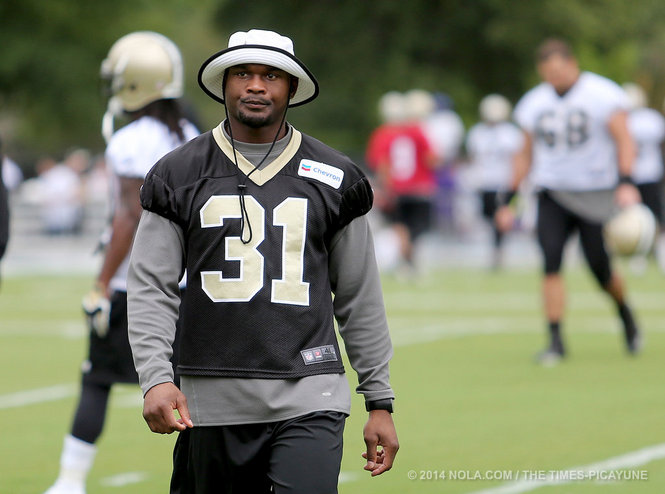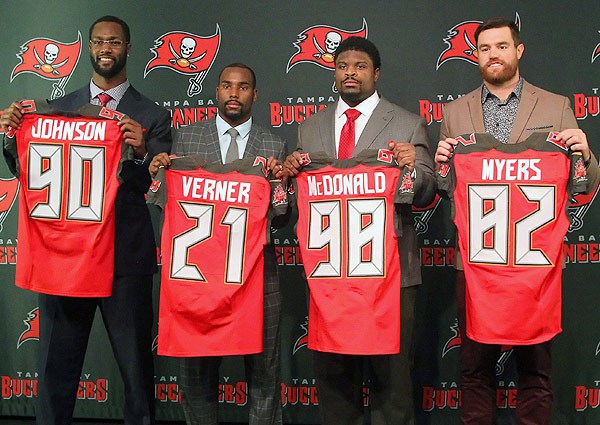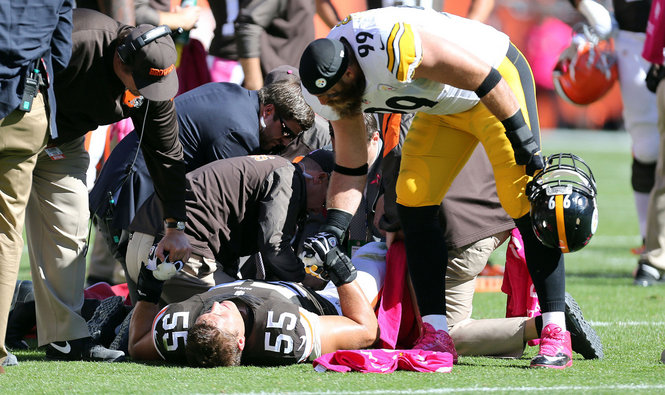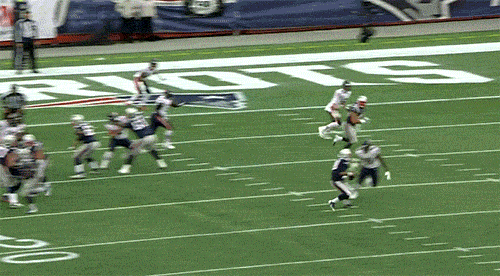After 2014’s Top Free Agent Class Mess, Who Wants to “Win”?
We’ve just wrapped up Week 1 of an exhilarating kickoff to NFL free agency – the kind of fast-paced wheeling and dealing that Twitter thrives on.
Judgments of who came out on top and who fell behind in this frenzied process are already circulating.
Fan bases from coast to coast are expressing their disappointment over their teams’ level of involvement.
But should you be dismayed if your team isn’t dominating the headlines with blockbuster deals?
Not if you remember what transpired just a year ago…
2014 marked a historically poor year for diving headfirst into high-stakes free agency contracts that supposedly crowned teams as “winners” in the realm of make-believe free agency accolades.
Opting not to sprint to the forefront this season and retrace steps that seldom yield success is considered a “loss.” Welcome to the wild world of the NFL.
Let’s review last year’s roster of top NFL free agents and the squads they joined.
NFL.com provided this specific Top 10 list before the commencement of last year’s free agency, and it glaringly illustrates why sometimes it’s advantageous to be on the “losing” side…
1) Jairus Byrd, S, New Orleans Saints. $11M signing bonus, $26M total of (maybe) guarantees
Considered by many to be the standout acquisition of last year’s free agency, Byrd appeared in just four games for the Saints in 2014.
On October 3, he was placed on injured reserve due to a torn meniscus in his knee, an injury sustained during practice.
Byrd experienced a rather tumultuous beginning to his time in New Orleans, undergoing back surgery shortly after signing his contract, which restricted his participation during much of the training camp.
As a result, it was hardly a shock that he appeared below his usual form in those four games before the knee injury.

Regarding return on investment, this contract is starting at a disadvantage.
The reported $26 million in guaranteed money is questionable, as after this season, only $6 million of his $7.4 million base salary was secured on the third league day of 2016.
For players, these types of “guarantees,” where the team has a decision, should be viewed as either a deadline for the team to request a restructuring or an exit strategy built into the contract for the team.
New Orleans can cut ties if Byrd doesn’t perform at the same level post-knee surgery or if the team realizes they won’t achieve the intended return on investment they had envisioned when they signed the player, regardless of his health.
2) Eugene Monroe, OT, Baltimore Ravens, $17.5M in guarantees
Among all the offensive linemen on the market a year ago, Monroe was widely regarded as the optimal blend of age and proficiency in both run-blocking and pass protection.
His re-signing with Baltimore was a logical move. The contract details are refreshingly uncomplicated for today’s standards, with the guarantees being concrete, encompassing only the signing bonus and base salaries for 2014-15.

Monroe had moments where he demonstrated the skill that earned him the contract. Still, his struggles with knee (in-season scope) and ankle injuries during the year resulted in him missing a career-high five games, including sitting out the team’s AFC Divisional loss to the Patriots.
When in good health, Monroe illustrated that he could remain a crucial piece in a Ravens offensive line that’s a team asset.
Unfortunately, the condition of being consistently healthy wasn’t a prominent factor in Monroe’s profile when they finalized the deal. It certainly is now.
While some may label last season as a “letdown” for Monroe, given that his terms are far from extravagant for a starting left tackle in the NFL and there’s still a substantial portion of the contract left, there remains a reasonable hope for a positive return on investment from this agreement.
3) Michael Johnson, DE, Tampa Bay Buccaneers, $18M in guarantees
Johnson was the top pass-rushing prospect on the market in free agency last season; a tall, agile player with the ability to disrupt the edge through sacks and a talent for deflecting passes and creating chaos in the pocket.

In under a year, Tampa let him go – absorbing the entire $18 million guarantee, including the $7 million they’ll pay him to play for the team they poached him from. Sheesh.
Johnson didn’t deliver the output the Bucs anticipated when they brought him on board. Still, this messy situation is more a reflection of the incompetence of the team handling the deal.
Few will be shocked if Johnson bounces back to his previous form in Cincinnati, though now at a more reasonable cost.
Johnson still has the potential to be a valuable player in this league. Still, he’s become the poster child for ill-advised NFL salary cap management, similar to an annulled Vegas wedding.
4) Alex Mack, C, Cleveland Browns, $18M in ’14 & ’15 guarantees, more “if” stuff after
Mack was widely regarded as one of the top center choices on the market a year ago and one of the premier centers in the league.
When Cleveland, his drafting team, managed to keep him on board, they earned praise for their shrewd move.
However, after Mack sustained a broken left fibula in October of the previous year, the Browns received only five games in return for their investment.

Mack’s contract features some distinct provisions: intelligent, player-triggered options for 2016-2018.
This means that if the turbulent situation in Cleveland persists, particularly regarding their quarterback situation, Mack can seek a more favorable environment after just two seasons.
Assuming Mack maintains his health and returns to top form in 2015, he will have participated in 21 games over two years for $18 million, with the freedom to pursue better opportunities elsewhere.
Unless a miraculous turn of events occurs for the Browns, the likelihood of this deal yielding a favorable return on investment is quite slim.
5) Lamarr Houston, DE, Chicago Bears, $15M in guarantees
Lamarr Houston was acquired from Oakland in a trade aimed at injecting some pass-rushing prowess into the Bears’ defense.
However, the Chicago defense struggled for various reasons, with pass rush being just one of them.
Houston’s performance was inconsistent in a defense that faced many challenges.
The low point came when Houston suffered one of the more memorable injuries of 2014, tearing his knee during a celebratory sack dance amid a lopsided loss.

With a new head coach, John Fox, the Bears have transitioned to a 3-4 defensive scheme.
The team has recently revealed their intention to “experiment” with utilizing the 300 lb Houston as an outside linebacker. We’ll see how that pans out.
Houston once showed great promise as a young player. However, after an unfortunate injury, a coaching shift, and a substantial financial commitment, this deal now appears to be the most improbable of long shots to deliver any meaningful value.
6) Jared Veldheer, OT, Arizona Cardinals, $10ishM in guarantees
Standing at an impressive 6 feet 8 inches, Veldheer stands out as the star of this group.
He brought a ray of hope to an otherwise struggling Cardinals offense, and his contract seems to have been a mutually beneficial arrangement thus far.
Veldheer represents a remarkable exception among last year’s top free-agent pool.
Hailing from a Division II school called “Hillsdale,” and having formerly played for the Raiders, his performance has been commendable. Take a moment to absorb that…
7) Branden Albert, OT, Miami Dolphins, $20M of guarantees through ’14 & ’15 with “if” stuff in ’16
Albert was widely regarded as one of the more reliable left tackles regarding pass protection as he entered free agency a year ago.
With the Dolphins having lost Jake Long to the Rams, pursuing Albert seemed like a reasonable move.
However, Albert only managed to play nine games for the Dolphins in 2014 before suffering tears to both his right ACL and MCL ligaments – a devastating blow.
The type of player Albert will be upon his return is uncertain, with a lot of uncertainty in the South Beach air.
Taking the cost into account, the perceived value in this deal seems to have already washed away.
8) Alterraun Verner, CB, Tampa Bay Buccaneers, $12M in real guarantees w/ $2M in “ifs” later
Tampa made two notable signings from the Top 10 free agent pool, which understandably led some to dub them as “winners” of the 2014 free agency period.
Assessing a cornerback’s performance can be challenging when the rest of the team is struggling, as was the case for Tampa last year.
Verner participated in 14 out of 16 games and is not recovering from any major injury, which is a significant positive on this list.
The ultimate verdict on whether this was a good deal will be made in the future, but as of now, it doesn’t carry the glaring signs of a poor one. So there’s that…
9) Michael Bennett, DE, Seattle Seahawks, about $14M in real guarantees with some “if” stuff later in ’16 & beyond
This signing was a smart move. The team managed to keep their player without resorting to the cap-straining approach that is all too common for pass rushers.
Bennett, often overlooked as a pass rusher, consistently applies pressure on the quarterback, even if his sack count may not be eye-popping and contract-worthy.
What sets Bennett apart is his reliability in showing up for every game. This is a clear indicator of a valuable signing in the making.
10) Aqib Talib, CB, Denver Broncos, $11.5M in 2014 guarantees, annual “if” stuff up to $20M in total “guarantees”
Talib was absent from just one game in 2014 and delivered a solid overall performance.
The real test of the deal’s worth with Talib will always come down to his game availability. So far, so good…
The crucial question here isn’t whether these players on the list possess talent – they all do.
The real issue lies in the quality of the deals and whether the teams will see the expected return on their investments.
For most of this group, achieving a favorable return on investment from this point forward is a steep challenge, and in the business of football, that’s what truly matters.
The astute teams in the NFL are acutely aware of this list. Strangely, refraining from participating in this year’s round of high-stakes, high-risk transactions is often portrayed as a “loss” in free agency.
However, it isn’t.
The entire notion of categorizing teams as “winners” or “losers” in free agency is somewhat nonsensical until we can determine years later if the team reaped the expected production and value from the deals.
Signing a player doesn’t secure a victory for the team. The real triumph comes when the player lives up to the deal. Conversely, it’s a loss if the player falls short.
It’s not as complicated as it might seem.
Football inherently involves managing risks across extensive rosters.
Those who willingly dive into treacherous waters usually do so out of sheer desperation.
The lessons from 2014 make it abundantly clear that desperation seldom pays off.
Opting not to align with the desperate teams can only be misconstrued as a “loss” by someone missing the bigger picture.
This is one of those fundamental truths in football that regrettably eludes the majority of stakeholders – both teams and fans.

